

Principles of the Elevations’ Paint
Winston-Salem, NC
click here to see illustrations

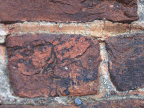 The purpose of this research is analyses of the
principles and traditions of the exterior paint of the historical buildings
in the Old Salem, dated 18th-19th cc. The discovered information is summarized in the present
report, which should be considered only as a preliminary one The research was limited by the lack of the adequate
statistical representation and difficulties with dating due to several
objective factors: The purpose of this research is analyses of the
principles and traditions of the exterior paint of the historical buildings
in the Old Salem, dated 18th-19th cc. The discovered information is summarized in the present
report, which should be considered only as a preliminary one The research was limited by the lack of the adequate
statistical representation and difficulties with dating due to several
objective factors:
- Some
paint layers were weathered unevenly on the wall surfaces. As a result
different samples from the same building and even on the same wall can
demonstrate different numbers and sequences of layers.
- It
was not possible to take samples from the top of the buildings under the
cornices.
- Most
of the historical buildings were not painted at the time of erection. That
means the first paint layers cannot be identified with the date of a
building construction.
- Archival
materials were not involved in this research.
At the same time, the current investigation gave us
undoubtfully valuable material and brought about some important conclusions
that can be used during
restoration work in Old Salem.
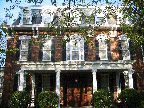 Most of the computer generated color copies presented
in this report maximally approach to the original colors discovered on the
elevations though some of them do not precisely reflect the exact initial
characteristics of the color. The
reason is in incompatibility of
the Pantone scale used in the identification of the paint and the limited
possibilities of the inkjet printer. However,
the printed colors are acceptable for
the paint analyses during this
preliminary phase of research. Most of the computer generated color copies presented
in this report maximally approach to the original colors discovered on the
elevations though some of them do not precisely reflect the exact initial
characteristics of the color. The
reason is in incompatibility of
the Pantone scale used in the identification of the paint and the limited
possibilities of the inkjet printer. However,
the printed colors are acceptable for
the paint analyses during this
preliminary phase of research.
We excluded from the current research the light
blue lines over the masonry joints that are visible almost on all of the
buildings in the town, since, visually, those lines can be dated by the
second half of the 20th century and are beyond the time frame of
this investigation.
Almost all of the buildings in the town were originally
decorated with
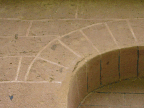 white lines along the joints. Some of them (such as
St. Phillips Church, South Moravian Church addition and Wash-Bake house)
have never been painted but at the same time white lines along the joints. Some of them (such as
St. Phillips Church, South Moravian Church addition and Wash-Bake house)
have never been painted but at the same time 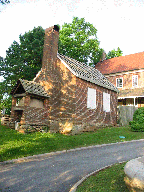 have
traces of a number of white layers over the joints. This type of decoration
can be considered a local tradition. The word “decoration”
relatively to the white lines is used conditionally. They could have been
applied for joints conservation in order to prevent joints from weathering
immediately after a building erection and before mortar has become
completely dried. The width of the white lines range
between 1/8” and 3/8”. have
traces of a number of white layers over the joints. This type of decoration
can be considered a local tradition. The word “decoration”
relatively to the white lines is used conditionally. They could have been
applied for joints conservation in order to prevent joints from weathering
immediately after a building erection and before mortar has become
completely dried. The width of the white lines range
between 1/8” and 3/8”.
There is no evidence of the original white lines over
the joints on the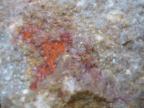 exteriors of the Main Hall (1855) and the John Sievers
House (1844). Perhaps it was a time period (around the middle of the 19th
century) when tradition was broken and elevations were first painted
and afterwards decorated with white lines along the joints. exteriors of the Main Hall (1855) and the John Sievers
House (1844). Perhaps it was a time period (around the middle of the 19th
century) when tradition was broken and elevations were first painted
and afterwards decorated with white lines along the joints.
These findings are differing from the existing opinion
that only the joints were painted with color. There are several arguments
confirming that the entire facades were
painted:
-
Spots of paint can be seen over the bricks at several places. They
are located on the East elevation of the Laundry House, North elevations of the
South Hall and East elevation of the Vorsteher’s House. On most other
elevations paint layers were weathered from the bricks and remain on the
joints.
- The
colored paint on the joints does not have any straight edges similar to
the white lines and they are spread along the brick surface together
with mortar. This means that the entire elevations were painted but only
at the joints due to stronger bond with the mortar the paint layers were
preserved. There is only one case of the colored lines over the joints:
the last layer on the East Elevation of the Vorsteher’s House.
However, even in this case the dark brown lines were applied over the
red paint of the entire elevation (late 19th or early 20th
century).
Further in depth research can verify or refute this
conclusion.
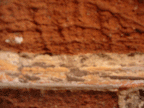 The Single Sisters’ House is currently undergoing
preservation work, which enabled us to investigate exterior paint more
precisely. Research of the Single Sisters’ House gave us interesting
results. First of all, the 1819
addition preserved the original 1786 South elevation from weathering. Two
paint layers were found on the 1786 gable: The Single Sisters’ House is currently undergoing
preservation work, which enabled us to investigate exterior paint more
precisely. Research of the Single Sisters’ House gave us interesting
results. First of all, the 1819
addition preserved the original 1786 South elevation from weathering. Two
paint layers were found on the 1786 gable:
- First,
the white lines were applied over the joints. It appears that the white
lines were drawn right after the building erection. The white color
penetrated the joint mortar and no dirt particles are visible on a joint
surface.
- The
second paint layer was red. It was significantly weathered before the
1819 addition due to a probably unstable mix of the paint. Only
small spots of the red paint remain in a few locations on the
gable. At some places the traces of the red paint spill over the brick,
which means that the second paint layer was applied to the entire façade.
 In fact, painted elevations mean dramatic changes in
architectural styles at the turn of the 18th and 19th
centuries. The American houses during Baroque and Classicism periods did not
have developed 3 dimensional exterior decorations in comparison to the
continental Europe. The main
method of decoration in America was a black header brick pattern. In the
early 19th century (Federal style in USA) the black header
pattern was gone from the exteriors,
which helped to their monumentalisation. Continental
Europe passed through a similar process: the number of facade details was
extremely reduced (Empire style). Old buildings there were adjusted to a new
fashion: multiple Baroque and
early Classical style details were removed from the exterior. The same
process is visible in this country, which was accomplished with a different
method. The black brick header pattern, which was almost the only decorative
detail in America, was painted over. In Old Salem In fact, painted elevations mean dramatic changes in
architectural styles at the turn of the 18th and 19th
centuries. The American houses during Baroque and Classicism periods did not
have developed 3 dimensional exterior decorations in comparison to the
continental Europe. The main
method of decoration in America was a black header brick pattern. In the
early 19th century (Federal style in USA) the black header
pattern was gone from the exteriors,
which helped to their monumentalisation. Continental
Europe passed through a similar process: the number of facade details was
extremely reduced (Empire style). Old buildings there were adjusted to a new
fashion: multiple Baroque and
early Classical style details were removed from the exterior. The same
process is visible in this country, which was accomplished with a different
method. The black brick header pattern, which was almost the only decorative
detail in America, was painted over. In Old Salem it was painted over with a
red brick color. Chronologically, the last building in the town where a
black header pattern was used was the Inspector’s House (1810). This time
is a chronological border between two different principals of exterior
decoration. It is a high possibility that the first red paint layer on the
original portion of the Single Sisters’ House was applied between 1810 and
1819. After 1819 the outside walls of the South addition were painted.
This was right after the completion of the construction work to
eliminate a difference between the old paint and new brick color. it was painted over with a
red brick color. Chronologically, the last building in the town where a
black header pattern was used was the Inspector’s House (1810). This time
is a chronological border between two different principals of exterior
decoration. It is a high possibility that the first red paint layer on the
original portion of the Single Sisters’ House was applied between 1810 and
1819. After 1819 the outside walls of the South addition were painted.
This was right after the completion of the construction work to
eliminate a difference between the old paint and new brick color.
A black header pattern is more expensive than a regular
masonry elevation surface. That means it did not make sense to cover the
pattern with paint. So the important conclusion can be deduced as a result
of this research: the first exterior paint layer appeared in Old Salem
not earlier than the 1810s.
 A black (dark gray) color appears on some of the
buildings in the Central part of the town and can be dated back to the late
Victorian time period. In some cases (Boy’s School) the dark gray color
looks like a dirty or smoked surface. This can be explained by several
factors: a fire could have occurred at this location that shall be verified
by the historical documents, or effect of smoke from an intensive workshop
which used the industrial stoves. The dark gray color exists as a fourth
coat for the front door decoration of the Moravian church. Similar color was
discovered on two other houses. The Inspector’s House has dark gray
color as a second layer on the exterior of the 1850 addition. On the Lehman
Hall (1892) this color was used as a second layer. The conclusion is that
the dark gray (black) color was used in Old Salem in the second half of the
19th century. A black (dark gray) color appears on some of the
buildings in the Central part of the town and can be dated back to the late
Victorian time period. In some cases (Boy’s School) the dark gray color
looks like a dirty or smoked surface. This can be explained by several
factors: a fire could have occurred at this location that shall be verified
by the historical documents, or effect of smoke from an intensive workshop
which used the industrial stoves. The dark gray color exists as a fourth
coat for the front door decoration of the Moravian church. Similar color was
discovered on two other houses. The Inspector’s House has dark gray
color as a second layer on the exterior of the 1850 addition. On the Lehman
Hall (1892) this color was used as a second layer. The conclusion is that
the dark gray (black) color was used in Old Salem in the second half of the
19th century.
 A bright red color paint, accenting the exterior
details, was used in the town during the first five years of the 19th
century. So far it has been discovered on three buildings: Moravian Church,
Vierling House and South Hall. Evidence of this type of decoration can be
found on the front doors of all three houses. Color decoration was found
also around the windows and on the corners of the Vierling House. Currently,
the Vierling House’s front door, windows and corners are decorated with
red color. The existing design can be considered as a schematic one: the
original color was much brighter and more saturated; besides, joints are not
painted now, but they were painted initially. The existing dim color makes
sense, because current surrounding masonry surface is much darker and
dirtier now in comparison with the early 19th century. It
displays principles of the original architectural design. The
traces of the original red paint is seen on the exposed joints that were
left unpainted, which is a positive side of the current painting scheme of
the building. At the A bright red color paint, accenting the exterior
details, was used in the town during the first five years of the 19th
century. So far it has been discovered on three buildings: Moravian Church,
Vierling House and South Hall. Evidence of this type of decoration can be
found on the front doors of all three houses. Color decoration was found
also around the windows and on the corners of the Vierling House. Currently,
the Vierling House’s front door, windows and corners are decorated with
red color. The existing design can be considered as a schematic one: the
original color was much brighter and more saturated; besides, joints are not
painted now, but they were painted initially. The existing dim color makes
sense, because current surrounding masonry surface is much darker and
dirtier now in comparison with the early 19th century. It
displays principles of the original architectural design. The
traces of the original red paint is seen on the exposed joints that were
left unpainted, which is a positive side of the current painting scheme of
the building. At the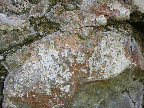 same time,
the painted joints could have displayed the historical truth and play a role
of conserving a paint layer, preventing joints and remnants of original
paint from weathering. A white layer was found behind the red on the mortar
of the Moravian Church and South Hall. It means the red decoration is not
the very first layer. Another possibility: all joints were covered first
with white and soon after that some elements were decorated with red color. same time,
the painted joints could have displayed the historical truth and play a role
of conserving a paint layer, preventing joints and remnants of original
paint from weathering. A white layer was found behind the red on the mortar
of the Moravian Church and South Hall. It means the red decoration is not
the very first layer. Another possibility: all joints were covered first
with white and soon after that some elements were decorated with red color.
 In the 19th century some of the buildings
had a reddish mortar. Perhaps a brick powder was added to the mix for better
strength. In some cases (St. Phillips Church) the color of the mortar is
almost equal to the color of the brick. In this case white lines over joints
definitely play a real decorative role. In the 19th century some of the buildings
had a reddish mortar. Perhaps a brick powder was added to the mix for better
strength. In some cases (St. Phillips Church) the color of the mortar is
almost equal to the color of the brick. In this case white lines over joints
definitely play a real decorative role.
 The South addition of the Moravian Church still
demonstrates the original white lines that were applied along the joints. The
lines remain only inside of the archway and are completely weathered on the
exterior surfaces. The fake
joints drawn on the brick are visible on the South arch. It
is the continuation of the white lines tradition, which was oriented on the
aesthetic goals. The South addition of the Moravian Church still
demonstrates the original white lines that were applied along the joints. The
lines remain only inside of the archway and are completely weathered on the
exterior surfaces. The fake
joints drawn on the brick are visible on the South arch. It
is the continuation of the white lines tradition, which was oriented on the
aesthetic goals.
Analyses show that the dark red and dark brown colors
appear in the late 19th century (table #1).
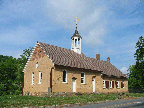 A brief research of exterior paint beyond Old Salem
shows similar results. Paint analyses in the geographically nearest German
settlement Bethabara gave us additional material of the red paint over
brick, stone and wood. An investigation of the Moravian architecture in
Bethlehem, PA discovered a number of buildings with red paint layers
preserved on heir elevations. What is more, red color was not uncommon in
other A brief research of exterior paint beyond Old Salem
shows similar results. Paint analyses in the geographically nearest German
settlement Bethabara gave us additional material of the red paint over
brick, stone and wood. An investigation of the Moravian architecture in
Bethlehem, PA discovered a number of buildings with red paint layers
preserved on heir elevations. What is more, red color was not uncommon in
other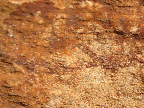 parts of the Western World. For example, some of the color layers on
the walls of the castle in San Juan (Puerto Rica, Spanish colony) are red.
The facades of the Riddarholmskikan Church in Stockholm dated by the
medieval age contain red color (not original, perhaps neoclassical era). For
Sweden, red color is basically a tradition. A lot of buildings there are
painted with local red pigment, which is beautiful and stable. For red color
on the Russian ancient buildings see attachment #1. parts of the Western World. For example, some of the color layers on
the walls of the castle in San Juan (Puerto Rica, Spanish colony) are red.
The facades of the Riddarholmskikan Church in Stockholm dated by the
medieval age contain red color (not original, perhaps neoclassical era). For
Sweden, red color is basically a tradition. A lot of buildings there are
painted with local red pigment, which is beautiful and stable. For red color
on the Russian ancient buildings see attachment #1.
Suggestions for continuation of the research:
- Each
building within defined time frame has to be included in a comprehensive
paint analysis research.
- It
is very important to investigate the walls behind the later additions
where applicable (such buildings as South Hall, Inspector’s House and
Single Sisters’ House).
- Research
locations where paint layers could have been better preserved: under
cornices, windowsills, canopies, porches, etc.
- Research
locations behind later built porches, stairs, chimneys, etc.
- Support
the research with archival material.
- Perform
chemical analyses of each paint layer to determine its components, type
of pigments and glue, proportion in the mix, etc.
- Determine
if pigments were partially or completely destroyed, chemically or due to
the light exposure.
- Date
each layer whenever possible.
- White
layers: determine which of them are applied to the entire elevations and
which of them are the lines along the joints.
- Investigate
various building parts, which could have been painted in different
colors: bases, front doors, corners, windows, etc.
- Investigate
paint of the exterior woodwork in order to have the information on the
entire color set of the elevations.
- Determine
painting over a brick or stone by researching the original wall cavities; weathered cavities cannot be
used for this task.
- Determine
the color context for the bright red color decoration on such buildings
as Moravian Church, South Hall and Vierling House
Attachment
#1
“Physical investigation of the church Znamenia on the
Sheremetev’s Court in Moscow, Russia (late 17th century) brought a very
interesting result. All the known paintings of the 19th century
depicted the church elevations entirely white
Paint analyses discovered layers of historical paint
under the cornices and windowsills. A classical yellow color was found
behind the whitewashing. Red and turquoise colors were located under the
yellow (late and middle of the 18th century). And finally,
evidence of the red paint was found directly on both bricks and joints. This
red color was discovered on the weathered brick, so it was concluded that
the exterior walls after the building was erected had a natural color and
texture of regular brick masonry. That conclusion became the base of the
restoration project.
Similar research was done on the Ivan The Great Bell
Tower in Moscow’s Kremlin. 20 layers of paint and whitewashing were
removed. The very bottom layer, which was determined to be the original one,
was red with white lines, which imitated masonry joints drawn over it. Those
drawn joints did not correspond with the real masonry joints.”
Editor E. Mechilovsky.
Restoration methodology.. Moscow,
1977. Edition House “Stroyisdat”. Page 51.
Selected
bibliography.
Kiselev,
Igor. Investigations of historic architectural finishes. Moscow,
Russia: Rosrestavratsia, 1993.
Kiselev,
Igor. Principles of reconstruction of lost details in dwelling houses of
the end of the 18th - beginning of the 19th centuries. Vilnius: Theses
of reports for the republican scientific conference "Improving the
research and restoration works of countryside mansions and their adaptive
reuse", 1984.
Kiselev, Igor. Survey of Architectural Artifact. USA
and Russian experience. Kyiv: Reports for the international scientific
conference "Problems and experience of protection of the historical
sites", 2002
Niven,
Penelope and Wright, Cornelia. Old Salem. The Official Guidebook. Old
Salem, Inc. Winston Salem, NC. 2000.
Paint
in America. The colors of historic buildings. National Trust for
Historic Preservation. Washington D.C. 1994.
Roger W.
Moss and Gail Caskey Winkler. Victorian Exterior Decoration. NY, NY,
1987.


MUSEUM
- TRAVEL
PRESERVATION
Wallpaper -
Gateways -
Necropolis -
Landscape
Splinters
Home
Please email to: vera.igor@gmail.com
|